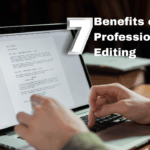5 Tips to improve your research article and make it reader-friendly

Some key highlights of this article:
- Get an expert’s insights on how you can improve your research manuscript and make it reader-friendly
- Apply the 5 actionable and powerful tips mentioned while writing your research paper
- Understand the nitty-gritty details of presenting data effectively in your paper
It is often daunting to write a good scientific manuscript that not only conveys your scientific accomplishments but also conveys them in a manner that is interesting and exciting to readers. For some, writing is an easy task; for others, it is a Herculean one.
Before a manuscript is published, you need to interest the journal editor and the peer reviewers through your writing. However, after the manuscript is published, your work also needs to be disseminated to a wider audience, especially since ‘being cited’ has become an important part of the scientific career progression.
As a graduate student, when I had to write my first manuscript, I was paranoid about writing and procrastinated writing my manuscript as much as possible. I found I did not enjoy writing and much preferred the bench work to communicate science. Of course, I knew I had to write it if I wanted to graduate.
Over the years, however, my preference has changed, and now I enjoy writing. Writing a research manuscript can be creative and fun, but one should always remember that writing needs to bring out the best of your research in a way that captures the attention of a wide audience. In this article, I will share a few pointers that have helped me immensely in my writing career. I hope these will help you too:
1. Get organized: A well-organized paper, with all the key elements important to conveying your study results will take you a long way in making your article reader-friendly. Organizing your thoughts is the first step to writing a clear and crisp manuscript. Understand your hypothesis or objective of the study and build on the necessary background required to set up that objective. The study details and appropriate logical discussion should follow. Further, knowing your readers and shaping the manuscript to cater to the target audience can considerably make your paper easier to understand.
2. Write a catchy and effective first page: The title and abstract are the first sections a reader would come across. These may be the only parts that are freely available to read irrespective of whether the journal is open access or paywalled. Thus, both title and abstract should be attention-grabbing and crisp, and also effectively summarize your entire manuscript.
Use several keywords that might help your paper stand out amongst the myriad of others while readers carry out their literature searches. Make sure to keep in mind the target journal guidelines. Many journals have word count limits and some clearly mention that abbreviations should not be used. Some journals require that the abstract be structured into subheadings such as “Background and Aims,” “Methods,” “Results,” and “Conclusions.” It is generally a good practice to follow this order even while writing the abstract in paragraph form.
Start with the reason for performing your study and your key questions or aims of the study. The first part should briefly touch upon the novelty of your study. Then write the methods used, including the basic study design and touch upon the key methodology used in the study. Key findings using the methodology should follow next, finally ending with a line on how your study will impact your field and why your study is important for other readers. Remember that the abstract should be simple, clear and concise, yet it should include all relevant information that you may want to be disseminated.
In addition to abstracts, several journals now allow the inclusion of graphical abstracts, lay summaries or video summaries. This helps simplify your research and findings for the audience and makes the manuscript more reader-friendly.
3. Look at the manuscript as an outsider: As you write the manuscript, keep in mind that someone who is not as involved in your study as you will be reading the manuscript. Therefore, write the manuscript precisely and clearly and convey the key story without repetition and without over-interpretation. Keep it simple, but effective. Avoid using jargon or decorative language, and also avoid sexist, racist, or overly informal language.
When I started writing my first manuscript, I knew all the details, so what I wrote made complete sense to me. But when I gave it to my colleague to proofread, he was able to point out several flaws, and asked me multiple questions; I had to practically re-do my manuscript. Therefore, if possible, have a colleague proofread your manuscript and use their invaluable outsider’s perspective. This will also help to tweak many aspects of your article. If possible, get a native English speaker to read your manuscript so that language issues, if any, can be addressed as well.
4. Include all key data to convey a complete story: Your manuscript should tell a complete story. Consider the story you would like to tell at the start and include all relevant data to that story. For instance, if you are a graduate student, you may have performed far more experiments than the ones that are necessary to tell your story. You need not include all the figures that you have created, but ensure that you include the ones needed to completely tell your story.
Be careful about splitting your data into two manuscripts simply to increase the number of publications. You can read the ICMJE guidelines on duplicate publication and salami slicing to ensure that you are adhering to the necessary ethical guidelines. On the other hand, sometimes, as you write, you may realize that you are missing an important piece of data to draw your conclusions. It would be imperative that you perform the necessary experiments (if possible at this stage) and include the data.
However, if this is not possible, you may include it as a limitation in your discussion and point out why you were unable to include this data. The inclusion of such a limitation will allow the reviewers and readers to realize that while you did think of such a scenario, you could not explore it in this manuscript.
5. Create effective illustrations: The last important point in effectively communicating your research is how to present your data. Typically, data can be illustrated as either tables or figures. Figures can be line charts, bar graphs, pie charts, or representative photographs. Make sure that you choose the appropriate format.
Remember that the readers must get the most out of seeing your illustrations. These must be stand-alone, such that they can be understood by reading the table titles or figure legends, without reading the text. Also, ensure to not repeat the same information in text, tables, and figures. Journal editors like the manuscript to be concise and not repetitive.
Whether or not you enjoy writing, if you are interested in pursuing a career in science or in research of any kind, honing your writing skills is imperative. And don’t worry; just like me, you too will climb this learning curve successfully!
Related reading:









